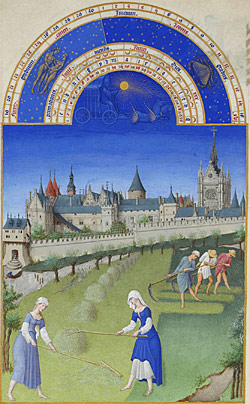
Unit 2: How Trade and Travel Changed the World
Lesson E: Rise of Early Europe
Lesson Overview


The painting Les Très Riches Heures du duc de Berry Showing the Harvest During the Month of June [1]
As large, powerful empires rose and fell throughout Asia and Africa during the Medieval Period, Europe remained an unstable region. The political and economic changes of the late Medieval Period were the first steps in Europe's eventual rise as a dominant region. These changes included the end of feudalism and the creation of more centralized kingdoms ruled by powerful monarchs. This shift accelerated the pace of global connectedness, allowing European states to access foreign goods and eventually influence development around the globe. These changes challenged the power held by Asia and Middle Eastern empires, and welcomed the world into the Modern Period.
Key Questions
- How and why did trade and interaction lead to changes in political, economic, and social systems?
- What factors contributed to the establishment, expansion, and decline of empires?
- How can there be different explanations for events in history?
Student Outcomes
- Analyze the role of the Black Death and Hundred Years War in the decline of European feudalism and eventual rise of nation-states.
- Compare the rise of individual states in Europe to centralized land based empires in Asia.
- Describe the role of the Italian city-states and the Portuguese in providing luxury goods such as silk and spices to Europe.
- Identify the author or source of historical document and explain the literal meaning of the source. (Historical Thinking Skill)
- Assess the uses and credibility of a source by examining personal and contextual influences and by corroborating with other historical sources. (Historical Thinking Skill)
Key Terms
- centralized rule
- city-state
- Classical Period
- Crusades
- dynastic
- feudalism
- globalization
- manorial system
- republic
Student Resources
- End of Feudalism Graphic Organizer (doc)
- European Trade Graphic Organizer (doc)
- Historical Investigation – The Portuguese and Italians Open Trade (doc)
- The Origins of a Euro-Centered World Brief Constructed Response (doc)
Chart of Activities:
| Activities to Complete | Estimated Time |
|---|---|
| Pre-Assessment | 5 minutes |
| Key Terms | 5 minutes |
| Activator: The World 1300-1550 | 5 minutes |
| Opening: Early Europe's Social Struggle | 10 minutes |
| Activity 1: Black Death, Royal War and the End of Feudalism | 15 minutes |
| Activity 2: Changes to the Feudal World | 10 minutes |
| Activity 3: The European Challenge | 10 minutes |
| Activity 4: Larger Empires | 10 minutes |
| Activity 5: Small States, Big Impact | 10 minutes |
| Activity 6: The Impact of Portugal | 10 minutes |
| Activity 7: The Impact of Italy | 10 minutes |
| Activity 8: The Expansion of European Trade | 15 minutes |
| Activity 9: The Portuguese and Italians Open Trade | 15 minutes |
| Review and Assessment | 15 minutes |
| Lesson Summary | 5 minutes |
Lesson Completion Time
The total estimated time to complete this lesson is 150 minutes.
Page Notes:
[1] Source: This image from http://commons.wikimedia.org/wiki/File:Les_Tr%C3%A8s_Riches_Heures_du_duc_de_Berry_juin.jpg is in the public domain because its copyright has expired.

